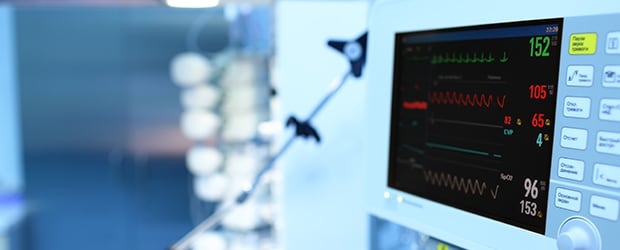
Application
Blood Pressure Sensors
Learn about the differences between invasive and non-invasive blood pressure monitoring and the medical sensor technology driving it.
Blood Pressure Monitoring with Medical Sensors
Heart rate, respiratory rate, oxygen saturation, body temperature, and blood pressure are all vital signs. Blood pressure is the pressure exerted by circulating blood on the walls of the blood vessel. Arteries and veins have different pressure levels. Normal resting blood pressure in an adult is approximately 120/80mm Hg. The two categories for blood pressure measurement are non-invasive blood pressure (NIBP) monitoring and invasive blood pressure (IBP) monitoring.

Invasive Blood Pressure Monitoring

Arterial blood pressure is most accurately measured invasively through an arterial line. Invasive arterial pressure measurement with intravascular cannulae involves direct measurement of arterial pressure by placing a cannula needle in an artery (usually radial, femoral, dorsalis pedis or brachial).
The cannula must be connected to a sterile, fluid-filled system, which is connected to an electronic pressure transducer. This invasive technique is regularly employed in human and veterinary intensive care medicine, anesthesiology and for research purposes.
IBP provides various clinical values. In surgical applications, the blood pressure is continuously and accurately measured, allowing medical staff to react to changes faster. For example, if anesthesia is given to the patient, the continuous monitoring can confirm it has not caused an adverse effect to the blood pressure. During certain operations, maintaining blood pressure in a very narrow range is critical; IBP creates the capability to monitor and maintain pressures. IBP also plays a critical role in situations where blood pressure is expected to fluctuate rapidly. By continuously monitoring the pressure, medical staff can be more timely and accurate in their reactions.
When to use:
- NIBP is not possible to use or when greater accuracy is required
- Blood pressure must be maintained in very narrow range for a period of time
- Blood pressure is expected to fluctuate significantly
- Continuous blood analysis is required
Method Comparison
| NIBP | IBP | |
|---|---|---|
| Advantage | No wound | Continuous, accurate and reliable blood pressure monitor |
| Application | Out-patient, tentative diagnosis | Intensive Care Unit (ICU), Operating theater |
| Disadvantage | Accuracy, depending on human operating factors | Penetration of blood vessel |

Non-Invasive Blood Pressure Monitoring

The principle of an Auscultator is that the rubber cuff stops the blood flow so the stethoscope or pressure sensor does not detect any pressure. When the valve is released and the artery is opened, the blood flow causes pressure fluctuation in the cuff which is recorded by a stethoscope or pressure sensor.
For each heartbeat, blood pressure varies between systolic and diastolic pressures. Systolic pressure is peak pressure in the arteries, which occurs near the end of the cardiac cycle when the ventricles are contracting. Diastolic pressure is minimum pressure in the arteries, which occurs near the beginning of the cardiac cycle when the ventricles are filled with blood.
Patients with instable hemodynamics are not advised to use NIBP monitoring as it does not provide accurate measurements for the following reasons:
- NIBP does not provide continuous pressure monitoring
- NIBP does not provide the wave of pressure

Piezoresistive Pressure Sensors
TE Connectivity’s 1620 and 1630 series pressure sensors are a fully piezoresistive silicon pressure sensor for use in invasive blood pressure monitoring. The sensor is designed to be used with automated assembly equipment and can be dropped directly into a customer's disposable blood pressure housing. A plastic cap is attached to the ceramic substrate to provide an easy method of attachment to the customer’s assembly and protection for the sensing element. A dielectric gel is placed over the sensor to provide electrical and fluid isolation.





